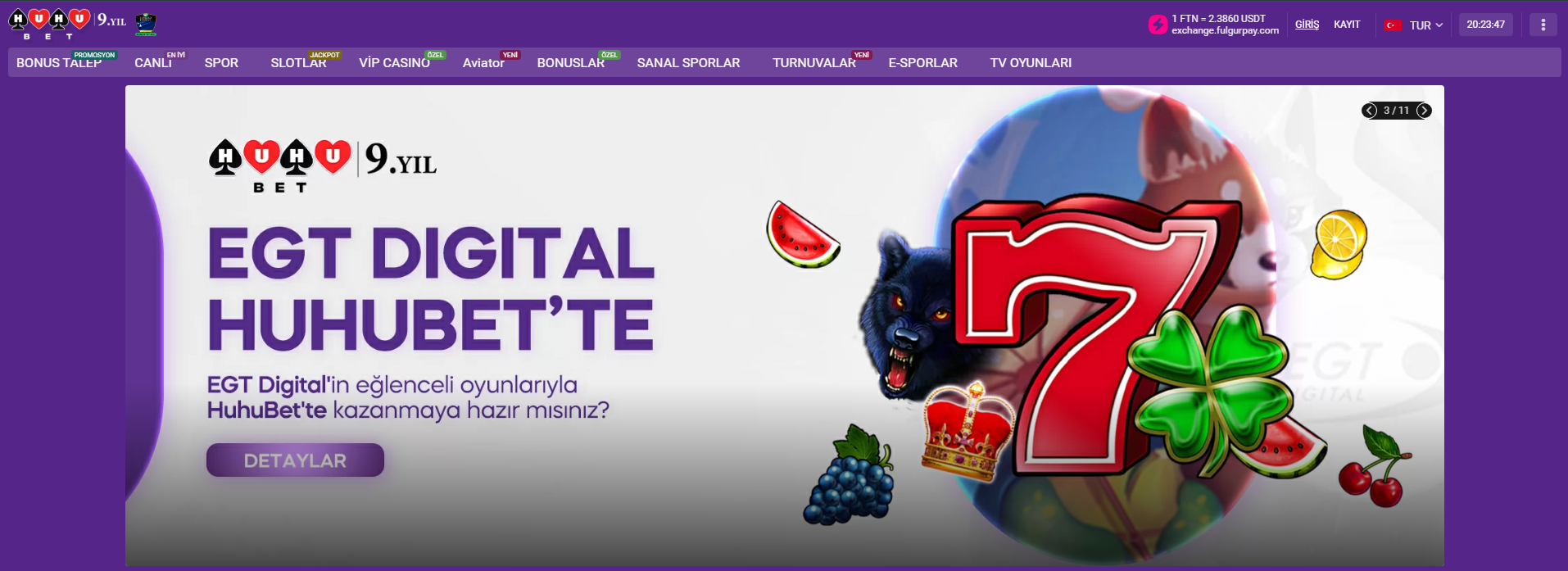Huhubet, çevrimiçi bahis ve casino dünyasında hızla adını duyuran ve sunduğu geniş oyun seçenekleri ile dikkat çeken popüler bir platformdur. Türkiye’deki bahis severler için özel olarak tasarlanmış olan Huhubet, kullanıcılarına spor bahislerinden canlı casino oyunlarına, slot oyunlarından sanal sporlara kadar pek çok farklı kategoride hizmet sunmaktadır. Hem yeni başlayan bahisçiler hem de tecrübeli oyuncular için ideal bir oyun ortamı sağlayan yüksek oranları, kullanıcı dostu arayüzü ve güvenilir altyapısı ile tercih edilmektedir.
Huhubet Giriş
Huhubet giriş yapmak oldukça kolay ve hızlıdır. Kullanıcılar, platformun ana sayfasındaki “Kayıt Ol” butonuna tıklayarak birkaç basit adımla hesap oluşturabilirler. Kayıt işlemi sırasında ad, soyad, e-posta adresi, kullanıcı adı ve şifre gibi temel bilgiler talep edilmektedir. Bu bilgiler girildikten ve kayıt işlemi tamamlandıktan sonra, kullanıcılar oluşturdukları hesap bilgileriyle giriş yaparak bahis yapmaya ve casino oyunları oynamaya başlayabilirler.
Huhubet, spor bahisleri alanında oldukça geniş bir yelpazeye sahiptir. Futbol, basketbol, tenis ve voleybol gibi dünya çapında popüler spor dallarında bahis yapma imkânı sunan platform, hem ulusal hem de uluslararası liglerde ve turnuvalarda yüksek oranlar sağlamaktadır. Özellikle futbol bahislerinde, kullanıcılar hem büyük liglere hem de yerel liglere bahis yaparak kazanç elde etme şansına sahip olurlar. Huhubet’in sunduğu canlı bahis seçeneği ise kullanıcıların maç esnasında anlık olarak bahis yapmasına olanak tanır. Canlı bahisler, dinamik yapısı ile bahisçilere daha stratejik hamleler yapma ve anlık kararlar alarak kazançlarını artırma imkânı sunar.
Huhubet Casino ve Canlı Casino Oyunları
Huhubet casino ve canlı casino oyunları konusunda da geniş bir seçenek sunmaktadır. Platform, slot oyunları, masa oyunları ve video poker gibi klasik casino oyunlarını kullanıcılarına sunar. Slot oyunları, farklı temalar ve büyük jackpot fırsatları ile dikkat çekerken, kullanıcılar klasik slot makinelerinden modern video slotlarına kadar pek çok farklı oyun seçeneği ile keyifli zaman geçirebilirler.

Canlı casino bölümü ise gerçek krupiyerler eşliğinde oynanan rulet, blackjack, poker ve baccarat gibi klasik masa oyunlarını içermektedir. Canlı casino, gerçek bir casino atmosferi sunarak kullanıcıların evlerinden çıkmadan bir casinoda oyun oynama hissini yaşamasını sağlar. Canlı krupiyerler eşliğinde oynanan oyunlar, oyuncuların gerçek zamanlı olarak stratejik hamleler yaparak kazançlarını artırma imkânı sunar. Canlı casino oyunları, özellikle sosyal bir oyun deneyimi arayan kullanıcılar için idealdir.
Huhubet Bonuslar ve Promosyonlar
Huhubet bonuslar ve promosyonlar kullanıcılarına büyük avantajlar sağlamaktadır. Platform, hem yeni üyelere hem de mevcut kullanıcılara çeşitli bonus fırsatları sunarak, bahis deneyimini daha kazançlı hale getirmektedir. Hoş geldin bonusları, yatırım bonusları, kayıp bonusları ve sadakat programları gibi farklı bonus seçenekleri, kullanıcıların daha fazla bahis yapmalarını ve kazançlarını artırmalarını sağlar.
Hoş Geldin Bonusu: Huhubet’e yeni üye olan kullanıcılar, platforma yaptıkları ilk yatırımla birlikte hoş geldin bonusu kazanma şansına sahip olurlar. Bu bonus, kullanıcılara ekstra bakiye kazandırarak daha fazla bahis yapmalarına olanak tanır.
Yatırım Bonusları: Huhubet, kullanıcılara düzenli olarak yatırım bonusları sunar. Her yatırım işleminde kullanıcılara ekstra bakiye sağlanarak, bahis yapma süreleri uzatılır ve kazanç fırsatları artırılır.
Kayıp Bonusu: Bahis veya casino oyunları oynarken kayıplar yaşayan kullanıcılar için sunulan kayıp bonusu, belirli bir orana kadar kayıpları telafi etme imkanı sunar. Kullanıcılar, kaybettikleri tutarın bir kısmını geri alarak tekrar bahis yapabilirler.
Sadakat Programı: Huhubet, platformu düzenli olarak kullanan ve sürekli bahis yapan kullanıcılarına sadakat programları ile ödüller sunar. Bu programlar, kullanıcılara ek bonuslar, promosyonlar ve özel ödüller sunarak, bahis deneyimlerini daha kazançlı hale getirir.
Huhubet Yeni Giriş
Huhubet yeni giriş Türkiye’de çevrimiçi bahis sitelerine uygulanan yasal düzenlemeler ve Bilgi Teknolojileri ve İletişim Kurumu (BTK) tarafından getirilen erişim engelleri nedeniyle, Huhubet gibi yurt dışı merkezli bahis siteleri zaman zaman erişim engelleri ile karşı karşıya kalabilir. Bu erişim engelleri, Türkiye’deki kullanıcıların Huhubet platformuna giriş yapmasını engelleyebilir. Ancak Huhubet, kullanıcılarının bahis deneyiminin kesintiye uğramaması için hızlı bir şekilde yeni giriş adresini devreye sokar ve kullanıcılarına kesintisiz hizmet sunmaya devam eder.
Huhubet’in yeni giriş adresi, erişim engelleri sonrasında devreye alınır. Genellikle ana domainin sonuna eklenen bir sayı veya harf ile oluşturulan bu yeni adres, kullanıcıların siteye kolayca erişimini sağlar. Örneğin, “huhubet.com” adresine erişim engeli getirildiğinde, yeni adres “huhubet123.com” olabilir. Bu küçük değişiklikler, kullanıcıların bahis deneyimlerini kesintisiz bir şekilde sürdürmelerini sağlar. Huhubet, yeni giriş adresini sosyal medya hesapları, e-posta bildirimleri ve SMS yoluyla kullanıcılarına duyurarak hızlıca bilgilendirme yapar.
Yeni giriş adresi üzerinden erişim sağlamak son derece kolaydır. Kullanıcılar, daha önce kullandıkları kullanıcı adı ve şifre bilgileri ile platforma giriş yapmaya devam edebilirler. Yeni giriş adresine geçiş yapılması, kullanıcıların hesap bilgilerini, bakiyelerini veya bonuslarını etkilemez. Huhubet, kullanıcıların tüm verilerini güvenli bir şekilde saklamaya devam eder ve platformun sunduğu hizmetler aynı şekilde sürdürülür. Bu sayede kullanıcılar, bahis yapmaya ve oyun oynamaya kaldıkları yerden sorunsuzca devam edebilirler.
Huhubet Güncel Giriş
Huhubet güncel giriş adresi, Türkiye’deki yasal düzenlemeler ve BTK’nın uyguladığı erişim engellemeleri nedeniyle zaman zaman güncellenmektedir. Türkiye’de çevrimiçi bahis sitelerine uygulanan yasal kısıtlamalar, giriş adresini değiştirerek güncel tutmasını zorunlu kılabilir. Ancak kullanıcılarının kesintisiz bir bahis deneyimi yaşaması adına bu duruma hızla adapte olur ve güncel giriş adresini hemen devreye sokar.
Güncel giriş adresine ulaşmak oldukça basittir. Kullanıcılar, Huhubet’in sosyal medya hesapları, e-posta bildirimleri ve SMS yoluyla yeni giriş adresi hakkında bilgilendirilir. Ayrıca, güvenilir bahis forumları ve bloglar da Huhubet’in güncel giriş adresini öğrenmek için etkili kaynaklar arasında yer alır. Bu kanallar üzerinden kullanıcılar, güncel giriş adresine hızlı bir şekilde erişerek platformda bahis yapmaya ve oyun oynamaya devam edebilirler.
Güncel giriş adresi üzerinden Huhubet’e giriş yapan kullanıcılar, hesaplarına aynı kullanıcı adı ve şifre ile erişim sağlayabilirler. Kullanıcıların hesap bilgilerini, bakiyelerini ve bonuslarını güvenli bir şekilde korumaya devam eder. Kullanıcılar, güncel giriş adresi üzerinden platforma sorunsuzca erişim sağladıktan sonra bahis ve oyun deneyimlerine kaldıkları yerden devam edebilirler. Huhubet, kullanıcıların bahis keyfinin kesintiye uğramaması adına güncel giriş adresini sürekli olarak güncelleyerek kullanıcılarını bilgilendirir.